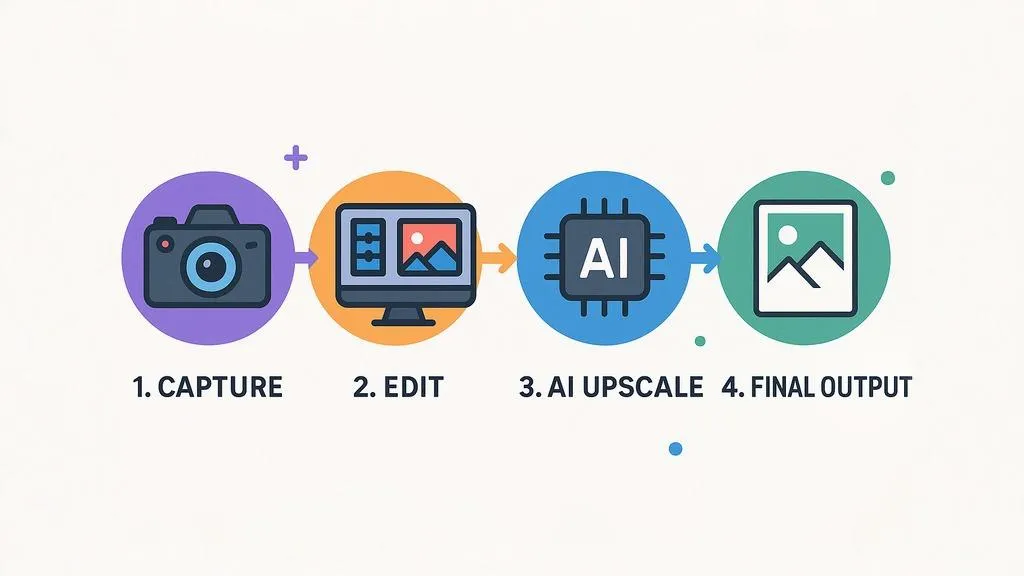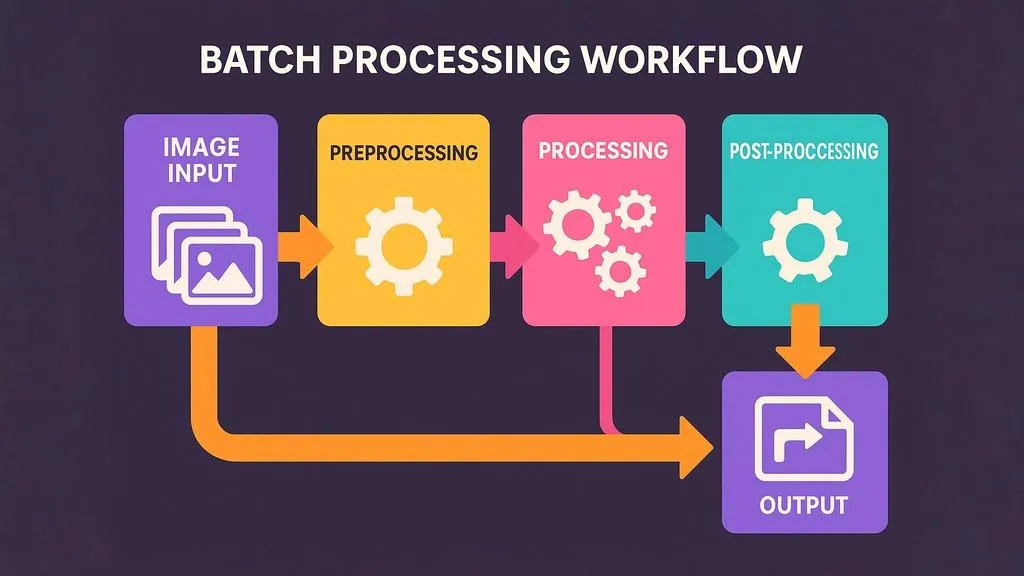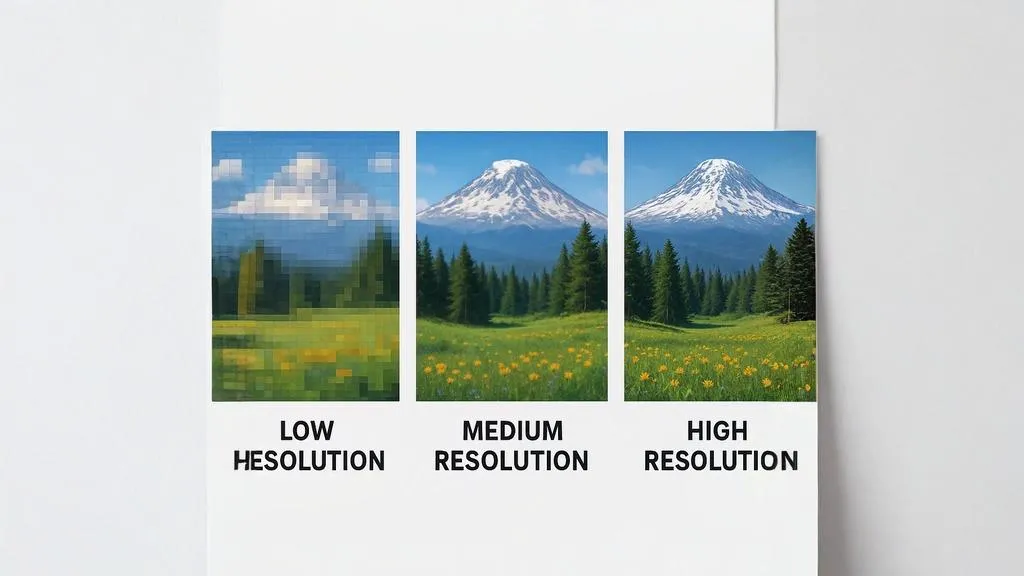The photography landscape is evolving rapidly with the emergence of AI-powered tools that are changing how professionals approach their craft. Among these innovations, AI image upscaling stands out as a technology that's becoming increasingly valuable in a photographer's workflow.
As both a professional photographer and an early adopter of AI enhancement technologies, I've worked with dozens of photographers to integrate these tools into their practices. In this article, I'll share insights from leading professionals about how they're using AI upscaling to expand creative possibilities, solve technical challenges, and deliver superior results to clients.

Modern photography workflow integrating AI upscaling as a final enhancement step
When Professional Photographers Turn to AI Upscaling
Professional photographers are using AI upscaling in scenarios that might surprise you. Here are the most common use cases I've observed:
Rescuing Technically Challenged Images
Even the most skilled photographers occasionally face technical limitations:
- When shooting in low light required higher ISO settings, resulting in noise
- When a fleeting moment forced a compromise on technical perfection
- When equipment limitations prevented capturing optimal resolution
- When atmospheric conditions (rain, fog, smoke) reduced clarity
Portrait photographer Lisa Chen notes: "I was shooting a wedding in a dimly lit cathedral where flash was prohibited. I had to push my ISO to 12800, which introduced visible noise. AI upscaling not only enlarged my images for the album but actually reduced the noise while enhancing facial details that were barely visible in the originals."
Cropping Freedom
Wildlife and sports photographers particularly value the ability to crop aggressively without losing quality:
- When the subject is distant and even a telephoto lens isn't enough
- When perfect composition wasn't possible in-camera due to fast action
- When discovering a compelling detail within a wider shot during editing
"I photographed a rare bird at a distance that occupied maybe 10% of my frame. Normally, cropping that aggressively would yield an unusable image for anything beyond small web display. With AI upscaling, I was able to create a gallery-quality print that revealed feather details invisible in my original capture." - Michael Torres, Wildlife Photographer
Creative Reinterpretation of Archival Work
Photographers with extensive archives are discovering new value in older work:
- Upgrading portfolio pieces shot on earlier, lower-resolution cameras
- Repurposing images for large-format displays that weren't originally intended
- Enhancing historically significant images for exhibitions
Landscape photographer David Winters explains: "I have images from 15 years ago shot on my first 8-megapixel DSLR that I never could print larger than 11×14 inches. Using AI upscaling, I've successfully created 30×45 inch gallery prints that stand alongside my work from modern 45-megapixel cameras."
Mixed Media and Composite Work
Photographers creating composite images or working across media formats find AI upscaling bridges technical gaps:
- Matching resolution of elements from different sources
- Incorporating scan-based elements (film, printed materials) into digital compositions
- Preparing photographic elements for large-scale installations
Pro Insight: Commercial photographer Rebecca Lin creates high-end advertising composites that often mix images from various sources. "When incorporating elements shot with different cameras or even stock photography into a unified composition, AI upscaling gives me consistent resolution across all components, eliminating one of the biggest technical challenges in composite work."
Integrating AI Upscaling into a Professional Workflow
Where exactly does AI upscaling fit in a professional photographer's workflow? Based on interviews with dozens of photographers, here are the most effective approaches:
The "Edit First, Upscale Last" Approach
Most photographers recommend completing your standard editing workflow before upscaling:
- Perform your normal culling and selection process
- Apply your typical raw processing workflow (color, contrast, exposure adjustments)
- Complete any retouching or pixel-level edits
- Save a master file at this stage
- Then upscale as the final step before output-specific processing
Wedding photographer Anthony Jensen explains: "I process hundreds of images from each wedding. I do my complete editing workflow in Lightroom and Photoshop first, then only upscale the images destined for large prints or album spreads. This saves time while ensuring the images that need that extra resolution get it."
The "Upscale Early for Retouching" Approach
Some portrait and beauty photographers prefer to upscale earlier in their workflow:
- Complete basic raw processing (color, contrast, exposure)
- Upscale the image before detailed retouching work
- Perform precision retouching on the higher-resolution version
- Apply final stylistic adjustments and output sharpening
Beauty photographer Sophie Wu notes: "For high-end beauty work where I need to do pixel-level skin retouching, I prefer to upscale first. The AI enhancement brings out subtle skin texture details that make my frequency separation retouching more precise, and the final result maintains a more natural look even after intensive editing."
The "Selective Enhancement" Approach
Advanced photographers sometimes use a hybrid approach:
- Complete basic editing on the entire image
- Export specific areas or elements that need enhancement
- Upscale only those elements
- Reincorporate the upscaled elements into the master composition
Advanced Technique: Architectural photographer Thomas Reed uses selective upscaling for his interior photography. "I'll often upscale only the areas with intricate details—like decorative moldings, fabric textures, or art pieces—then blend these enhanced elements back into my main image. This gives me precise control over where I apply the AI enhancement."
Technical Considerations and Best Practices
Professional photographers have developed specific techniques to get the best results from AI upscaling:
Noise Reduction Before or After?
There are two schools of thought among photographers:
- Before upscaling: Reducing noise in your original image can prevent the AI from interpreting noise as detail and amplifying it
- After upscaling: Some prefer to let the AI handle noise during upscaling, then apply targeted noise reduction if needed
The consensus from professionals is that light noise reduction before upscaling often yields the best results, especially for images shot at high ISO. However, extreme noise reduction before upscaling can remove too much detail for the AI to work with.
Color Profile Management
Professional photographers emphasize the importance of proper color management:
- Always work in 16-bit color depth when possible
- Use ProPhoto RGB color space for maximum color information
- Embed color profiles in your files before and after upscaling
- Check for color shifts after upscaling and correct if necessary
Sharpening Strategy
Photographers generally recommend:
- Apply minimal "capture sharpening" during raw processing
- Avoid or minimize "creative sharpening" before upscaling
- Let the AI upscaling handle the core enhancement of details
- Apply "output sharpening" after upscaling based on the specific destination (print, web, etc.)
Landscape photographer Elena Kowalski explains: "I've found the best approach is to apply minimal sharpening before upscaling, then apply a final targeted output sharpening after. The AI does an excellent job of enhancing real details, and too much pre-sharpening can create artifacts that the AI might misinterpret as structure."
Output Considerations
Professional photographers advise:
- Save upscaled master files as TIFF or PSD with layers when possible
- Create specific derivatives optimized for different output needs
- When printing, do test prints at smaller sizes to verify quality
- For web use, don't just downscale the upscaled image—optimize specifically for web
Tips for Specific Photography Genres
Different photography specialties benefit from specific approaches to AI upscaling:
Portrait Photography
- Focus on maintaining natural skin texture while enhancing details in eyes, hair, and clothing
- Use selective upscaling for the face while applying standard enlargement to less critical areas
- Check carefully for any unnatural sharpening in skin transitions
- For group portraits, pay special attention to consistent enhancement across all faces
Landscape Photography
- Look for improvements in fine texture areas like foliage, rock formations, and water details
- Be cautious with very smooth gradient areas like clear skies, which can develop banding
- Consider more aggressive upscaling for scenes with lots of intricate details
- Verify that atmospheric effects (haze, fog) maintain their natural quality
Wildlife and Sports Photography
- Prioritize detail enhancement in the subject over background elements
- Pay special attention to fur, feathers, and textural elements
- Use upscaling to recover details in heavily cropped action shots
- Be watchful for noise amplification in images shot at high ISO settings
Product and Still Life Photography
- Focus on enhancing texture and material details that communicate product quality
- Ensure text remains crisp and readable after upscaling
- Verify that reflective surfaces maintain realistic properties
- Use upscaling to emphasize craftsmanship details in luxury products
Real-World Results: Before and After Case Studies
Case Study 1: Salvaging a Once-in-a-Lifetime Wildlife Moment
Wildlife photographer Carlos Mendez was photographing birds in the Amazon when he captured a rare interaction between species that had never been documented before. The image was shot at extreme distance with heavy cropping:
- Original capture: 24MP camera with 600mm lens + 1.4x teleconverter
- Cropped image: Approximately 3MP effective resolution
- After AI upscaling: Enhanced to 12MP with significant detail recovery
- Result: Image was published in National Geographic with a double-page spread
"The original crop was barely usable for web display," Carlos explains. "After AI upscaling, not only could the image be printed at magazine quality, but ornithologists could identify specific markings that helped confirm the significance of the behavior I'd captured."
Case Study 2: Rescuing Underexposed Wedding Photos
Wedding photographer Aisha Johnston faced a challenging reception venue with minimal lighting where flash would have disrupted the atmosphere:
- Original images: Shot at ISO 12800 with significant underexposure to maintain shutter speed
- Initial processing: Exposure correction introduced visible noise and detail loss
- AI upscaling approach: Minimal noise reduction before upscaling, then selective enhancement
- Result: Delivered album-quality images that captured the venue's ambiance without technical compromises
"The clients were concerned about the dark venue, but I assured them we could work with it," Aisha says. "What I didn't tell them was how much I'd be relying on AI upscaling to rescue those images! The final album exceeded their expectations, with rich details even in the candid moments captured in near darkness."
Case Study 3: Revitalizing a Photography Archive
Commercial photographer Robert Kim had a 20-year archive of work that included images from early digital cameras:
- Original files: Many important portfolio pieces shot on 6-10MP cameras from 2003-2008
- Challenge: Clients requesting high-resolution versions of these older works for new uses
- Solution: Batch processing through AI upscaling to create modern-resolution versions
- Result: Extended the commercial viability of his archive by 15 years
Business Impact: "My archive went from a nostalgic portfolio to a revenue-generating asset," Robert explains. "Images I shot on a 6MP Canon in 2005 are now being licensed for uses that require 20MP+ resolution, generating thousands in additional income from work I'd already completed."
Common Mistakes to Avoid
Based on feedback from professional photographers, here are the most common pitfalls when incorporating AI upscaling:
Upscaling Too Early
Processing original raw files through your normal workflow first almost always yields better results than upscaling JPEGs or unprocessed images.
Over-Relying on AI Enhancement
AI upscaling works best when treated as one tool in your workflow, not a replacement for good capture technique or thorough editing.
Inappropriate Expectations
AI can't create detail that doesn't exist in some form in the original. Extremely out-of-focus or motion-blurred images may upscale to larger sizes but won't magically become sharp.
Not Scrutinizing Results
AI occasionally creates artifacts or unnatural textures. Always review upscaled images carefully at 100% view before delivering to clients.
Applying One-Size-Fits-All Settings
Different images benefit from different upscaling approaches. Experiment with settings rather than batch processing everything identically.
The Future of AI in Professional Photography
How do professional photographers see AI upscaling evolving in their field?
Integration with Editing Software
Most photographers anticipate deeper integration of AI upscaling directly within their primary editing tools, removing the need for separate processing.
Camera Integration
Some foresee camera manufacturers incorporating real-time AI upscaling into their hardware, potentially changing how resolution is approached in camera design.
Specialized AI for Different Subjects
Photographers expect more specialized AI models trained for specific photography genres—dedicated portrait, landscape, or wildlife upscalers that understand the unique characteristics of each subject type.
Video Applications
As more photographers offer hybrid shooting (stills and video), there's growing interest in applying similar upscaling technology to video footage.
Conclusion: A New Tool, Not a New Direction
The photographers I interviewed consistently emphasized that AI upscaling hasn't fundamentally changed what they do, but rather expanded what they can deliver to clients. It's become another tool in their professional toolkit—one that solves specific problems and opens new possibilities.
Commercial photographer Elaine Winters perhaps summarized it best: "I still approach every shoot with the same care and attention to technical excellence that I always have. AI upscaling hasn't made me less careful about my technique—it's made me more adventurous about what I can promise to deliver. It's expanded my creative freedom by providing a safety net for technical limitations that were previously insurmountable."
For professional photographers looking to stay competitive in an evolving industry, AI upscaling offers a way to extend capabilities, enhance deliverables, and extract more value from both new work and existing archives.
Ready to integrate AI upscaling into your professional photography workflow? Try our tool with your challenging images and experience the difference that professional-grade AI enhancement can make.


